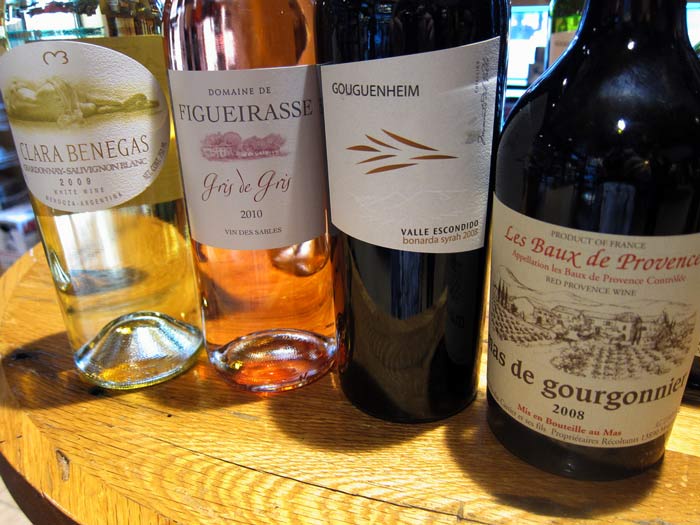“You note the dark color of the red in the glass, its ruby clarity against the light. The perfume is reminiscent of the wild rosemary of the Provencal hillside. So soon after the strong food, the first sip seems almost gentle—but then one seems to sense the taste of more herbs—laurel, savory, thyme—and finally, believe it or not, there follows the lightest touch of peppermint in your throat as the wine goes down. The whole effect is curious, but rather attractive and you’re impelled to finish the glass.”
– Roy Andries de Groot in his essay A Beach Picnic in Provence (and a Discourse on Olive Oil and Olives)
Most lovers of books can recite verbatim a particular passage or line that made them quake. For me, it was philosopher Will Durant’s description of George Santayana:
“Hardly since Plato had philosophy phrased itself so beautifully; here were words full of a novel tang, phrases of delicate texture, perfumed with subtlety and barbed with satiric wit; the poet spoke in these luxuriant metaphors, the artist in these chiseled paragraphs. It was good to find a man who could feel at once the lure of beauty and the call of truth,” (The Story of Philosophy, 533).
I remember the exact moment when I first read that. Perhaps it struck me so because he described something much like one would describe food—tang, delicate texture, perfumed, barbed, luxuriant. Perhaps it was my childhood love of Tang and its mention in such a passage in such a way that moved me so. Seriously. I have no shame in this regard. Whatever it was, I’ve never forgotten it and am grateful I have this moment to call my own.
I do not have this for food writing.
Review after review, book after book, I have yet to quake. But I came close back in July when reading about Provence in Roy Andries de Groot’s In Search of the Perfect Meal. A month or so later, it was Friday night at Marion Street Cheese Market. This meant there was a free tasting. Yes, free and every Friday evening. On this particular evening, Leigh Mabry from H2Vino was pouring four wines including a 2008 Mas de Gourgonnier Red (around $20) from Provence. I immediately thought of de Groot’s descriptions of Provence, and in particular, his mouth-watering recollections of some nameless red that plumed the air with laurel and savory and thyme and wild rosemary before it so thoughtfully cleansed the palette with a touch of peppermint. Yes, please.

The wine was everything I had wanted. I realized just then I’ve been drinking too much sweet, oaked red, for this wine seemed to cut through a film that I knew existed only in my mind. Delicate, non-fruit aromas mingled with a restrained-fruit backdrop; acidity nudging me to crave just one bite of something to quell the chemistry; this is perfect food wine.
This experience has stayed with me, especially because I intended on writing about it. Last week, I was pouring for someone samples of Merlot and Carmenere. They came undone at the Carmenere for the same reasons that I found the Gourgonnier Red so arresting. After some discussion about the obscure grape – Carmenere – we stumbled upon something that made us all pause: The wines grown in South America are more French than anything grown in France.
Like a needle skidding across the ridges of a record, time was interrupted and an abrupt correction began to form. We spent the next couple of minutes talking with genuine interest about things that never get talked about on a lazy Wednesday afternoon: the history of wine and phylloxeria and genetics and grafting. All of the chatter could be distilled down to one simple story.
When the French colonized South America, they brought with them their vines. These vines flourished in Chile and Argentina. Meanwhile, back in France, the vines became infected with a bug called phylloxeria. The French were freaking out. I remember one story in which the vineyard owners were even instructing folks to urinate on the roots in an effort to halt the mysterious scourge. Can you imagine this? The picturesque scene of folks trimming the vines, testing the grapes and pee. Everywhere. Eventually, the Americans were to blame. Like a dirty lover, we infected the pristine and delicate French rootstock with something we were already immune to. The cure was just as invasive: grafting our American and immune rootstock with the dying French stock. This combination yielded heartier vines that could resist the nasty invasion.
Phylloxeria never made it to Chile. Nor to Argentina. At least not in any comprehensive way. Part of this is to do with the high altitudes creating a hostile environment for the phylloxeria.
This one simple piece of story gives me a much deeper appreciation for South American wines. And while it isn’t full of flowery language making me drool, the idea itself stirs not just something worthy of pause but purchase.